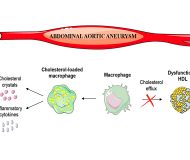

Researchers from IIB Sant Pau, IISFJD, CIBERDEM and CIBERCV have discovered that the lipoproteins of these patients reduce their ability to prevent the accumulation of cholesterol in the macrophages of the arterial wall. The discoveries of this new work may open new therapeutic possibilities for patients with this disease by increasing HDL functionalities.
Abdominal aortic aneurysm (AAA) is a permanent dilation of the aorta that affects approximately 5% of men over 50 and more than 1% of women over 65. The rupture of AAA is a major cause of death in our country and, at present, there are no pharmacological treatments that help prevent the progression of the disease, surgical intervention being the only therapeutic alternative.
Now, a new study in which researchers from the Center for Biomedical Research on the Net (CIBER), belonging to its areas of Diabetes and Associated Metabolic Diseases (CIBERDEM) and Cardiovascular Diseases (CIBERCV), participate, could open up new treatment possibilities by identifying the mechanisms by which lipoproteins that transport good cholesterol (HDL) lose their cardioprotective capacity in patients with AAA.
The work, published in the journal Arteriosclerosis Thrombosis and Vascular Biology, has been developed by researchers from CIBERDEM at the Research Institute of the Hospital de la Santa Cruz y San Pablo in Barcelona, and from CIBERCV at the Health Research Institute of the Fundación Jiménez Díaz in Madrid, led by Juan Carlos Escolà-Gil and José Luis Martín-Ventura, respectively, in collaboration with Finnish and Danish researchers.
Role of cholesterol in the progression of abdominal aortic aneurysm
AAA is generally characterized by the accumulation of cholesterol and infiltration of macrophages in the aortic wall. “The objective of this research focused on evaluating the composition of circulating HDL particles and their potential to promote the flow of cholesterol expulsion from macrophages in subjects with AAA,” explains José Luis Martín-Ventura.
“The findings allow us to conclude that patients with AAA present alterations in the composition of the HDL and a reduction in their main cardioprotective function: their capacity to prevent the accumulation of cholesterol in the macrophages of the arterial wall”, states Juan Carlos Escolà-Gil.
The work showed for the first time that, in these patients, the elimination of cholesterol from the macrophages caused by HDL is defective. The patients presented low levels of apolipoprotein A-I and particles preβ-HDL and alteration in the flow of cholesterol expulsion from macrophages. “This is an important functional alteration of the HDL that could be mechanically linked to AAA”, adds the first signatory of the work, Diego Martínez-López.
“These results may open up new therapeutic possibilities for patients with this disease by increasing HDL functionalities,” the researchers conclude.
Reference articles:
Impaired HDL (High-Density Lipoprotein) -Mediated Macrophage Cholesterol efflux in Patients With Abdominal aortic Aneurysm. Diego Martínez-López, Lidia Cedó, Jari Metso, Elena Burillo, Annabel García-León, Marina Canyelles, Jes S. Lindholt, Monica Torres-Fonseca, Luis Miguel Blanco-Colio, Jesús Mª Vázquez, Francisco Blanco-Vaca, Matti Jauhiainen, Jose Luis Martín-Ventura, Juan Carlos Escolà-Gil.
DOI: 10.1161 / ATVBAHA.118.311704
Also participating in the study were researchers Elena Burillo, Mónica Torres-Fonseca and Luis Miguel Blanco-Colio from CIBERCV and from the Health Research Institute of the Fundación Jiménez Díaz-Universidad Autónoma de Madrid, Jesús Vázquez from the Carlos III National Cardiovascular Research Centre and CIBERCV, the Jes Lindholt University Hospital in Odense, Matti Jauhiainen and Jari Metso of Minerva Instituto de Investigación Médica y Lídia Cedó, Annabel García-León, Marina Canyelles of CIBERDEM, and Francisco Blanco-Vaca of CIBERDEM, Head of the Research Group on Metabolic Basis of Cardiovascular Risk at IIB Sant Pau and of the Biochemistry Service of the Hospital de la Santa Creu i Sant Pau in Barcelona.